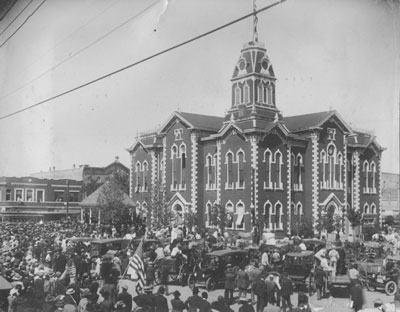
Over the past few months, I encountered several statements about topics I research that are not in line with each other. For example, since the early 1900s there has been a myth that the first District Court was held under a tree. When Court adjourned, the Judge and Prosecuting Attorney called for a gallon of whisky to celebrate the event. Because it survived for years, many local residents believe it’s truth; even though three trees are named as the site.
The first tree was beside the first courthouse that in reality wasn’t even there. The second tree was in the backyard of a prominent woman who was not born when the first court was in session. The third tree was outside the townsite which would never have occurred. To be perfectly honest, the first session of the 7th District Court in Hunt County did not occur in November 1846 for the very simple reason that no location for the county seat had been chosen. Texas law required courts to be held at the county seat in the courthouse and nowhere else.
Well, you say, Hunt County was created in April 1846, organized in August of that year, so there surely was a location for the town of Greenville. Nope! The 54 men who gathered somewhere to organize the county government could not agree on the site of the new county seat.
There were two sites offered, both with very good credentials. The first was near Center Point, about where the car wash is on FM 1570. The other was the present location. Both sites were to be donated to the county that was in financial woes from the start.
The Center Point site had adequate water, a supply of timber for heating and construction, and good grasslands. All were significant attributes for locating homes and towns. The other site had limited water, lacked timber, but was supported by Colonel James Bourland, an extremely influential man in all of Northeast Texas. Guess what eventually had more influence? Colonel Bourland and his protégée, McQuinney H. Wright.
Over the years, whopping good tales have sprung up about the location of the townsite. One woman, a descendent of Mr. Wright, told that he had a store out on the open prairie. A cowboy rode up in need of an item of clothing. Wright told the cowboy if he voted for Wright’s site, he would get a free set of clothing.
Another tale was told in at least three towns trying to locate their county seat. Supposedly a heavy rainfall filled one of the creeks, making it difficult to cross. One man either was scared to cross or his horse balked, and the Wright site received one more vote.
Charles DeMorse, the editor of the Clarksville Northern Standard, wrote about the Center Point site in November 1847; but in January 1848 he reported the sale of town lots where Greenville is today.
How did I put this raveled tale together? Judge L. L. Bowman of Hunt County rode the circuit in the late 1890s when he listened to old-timers during court recesses. He was a well-educated attorney and historian who had access to county and district court records as well as old copies of the Northern Standard. He was also aware that no self-respecting judge and prosecutor would offer free liquor in the court room. In July 1932 he wrote an article for the Greenville Evening Banner, in which he reported his investigation and conclusion that Greenville was located by one vote. He also noted that at that time M. M. Knight, who dug the water well, kept an excellent tavern on the south side of the square.
